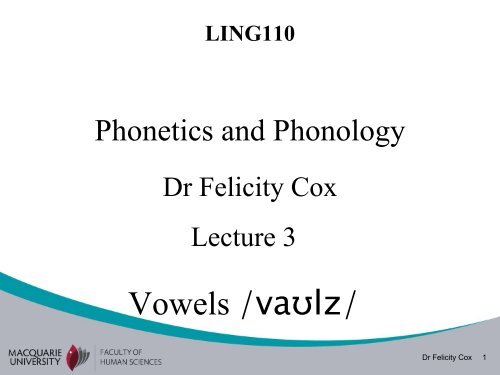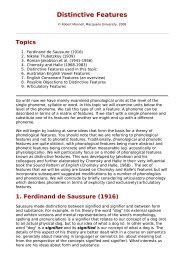Vowels /vaʊlz/
Vowels /vaʊlz/
Vowels /vaʊlz/
You also want an ePaper? Increase the reach of your titles
YUMPU automatically turns print PDFs into web optimized ePapers that Google loves.
LING110<br />
Phonetics and Phonology<br />
Dr Felicity Cox<br />
Lecture 3<br />
<strong>Vowels</strong> /<strong>vaʊlz</strong>/<br />
Dr Felicity Cox 1
Aims<br />
Reinforce the notion that vowels and consonants function<br />
differently in language<br />
Explain the articulatory basis for vowel classification<br />
Discuss important vowel features<br />
Outline the transcription of English vowels<br />
Describe the two main classes of vowels: monophthongs<br />
and diphthongs<br />
Dr Felicity Cox 2
Consonants <strong>Vowels</strong><br />
-constricted vocal tract - more open vocal tract<br />
-low amplitude - much louder<br />
-short, change rapidly - longer, slowly changing<br />
-mark edge of syllables - mark the syllable’s centre<br />
multilayered information:<br />
- accent differences<br />
- personal attributes<br />
- intonation / emphasis<br />
Dr Felicity Cox 3
Phonetic Features for Vowel Classification<br />
Initiation of Airflow - vowels are pulmonic<br />
Voicing - vowels are voiced<br />
Direction of airflow - all vowels are central<br />
- can be oral or nasal<br />
Oral Constriction -Degree = Vowel Height<br />
Backness<br />
-Position = Vowel<br />
Dr Felicity Cox 4
Additional Vowel Features<br />
Round - vowels can be produced with<br />
rounded or unrounded lips<br />
Length - vowels can be long or short<br />
Dr Felicity Cox 5
Vowel Space<br />
Height and backness are used to define the<br />
vowel space.<br />
When we produce vowels, the tongue forms an<br />
arch.<br />
The apex of the arch is the Highest Point of the<br />
Tongue (HPT).<br />
Dr Felicity Cox 6
Potential Human Vowel Space<br />
Potential vowel space<br />
/i/ /ʊ/<br />
/æ/ /ɑ/<br />
Dr Felicity Cox 7
Backness<br />
refers to the horizontal position of HPT.<br />
front vowels - HPT is below the hard palate<br />
/i,ɪ,e/ e.g. “bead, bid, bed”<br />
back vowels - HPT is in the velar/pharyngeal<br />
region<br />
/ʊ,ɔ,ɒ/ e.g. “good, board, pod”<br />
central vowels - HPT is between front<br />
and back<br />
guard”<br />
/ə,ɜ,a/ e.g. “above, bird,<br />
Dr Felicity Cox 8
Height<br />
refers to vertical movement of the HPT<br />
high vowels - the HPT is high but does not<br />
cause an obstruction to the flow of<br />
air<br />
/i, u, ʊ/ e.g. “bead, rude, good”<br />
low vowels - the HPT is low -- the<br />
mouth is open the jaw is lowered<br />
• /a, ʌ/ e.g. “card, cud”<br />
mid vowels - between high and low<br />
/e, ɒ/ e.g. “pet, pot”<br />
Dr Felicity Cox 9
Vowel Space<br />
(Height x Backness Space)<br />
The space is typically quadrilateral in shape.<br />
It is also (and primarily) an auditory space.<br />
We hear vowels as similar or different from<br />
each other depending on their proximity in this<br />
space.<br />
Dr Felicity Cox 10
Australian English Vowel Space<br />
Dr Felicity Cox 11
Dr Felicity Cox 12
Vowel Dispersion<br />
Languages prefer vowels to be maximally<br />
dispersed in the vowel space.<br />
This assists intelligibility.<br />
When vowels of an accent change, they often<br />
remain dispersed in this space.<br />
Dr Felicity Cox 13
Round<br />
In most English accents, back vowels and [u] are<br />
produced with rounded lips.<br />
/u, ʊ, ɒ, ɔ/ e.g. “cooed, could, cod, cord”<br />
Languages tend to prefer back vowels to be<br />
rounded and front vowels to be unrounded but<br />
there are exceptions<br />
e.g. French: front rounded vowels [y]<br />
Japanese back unrounded vowels [ɯ]<br />
Dr Felicity Cox 14
Length<br />
long heed, who’d, heard, hoard, hard<br />
short hid, hood, head, hod, had, hub<br />
English short vowels don’t occur in open<br />
syllables (syllables that end in a vowel).<br />
Dr Felicity Cox 15
Schwa /ǝ/<br />
by far the most common vowel in the English<br />
language<br />
typically found in function words (unless they are said in<br />
isolation): for, the, but, should, can etc.<br />
the schwa vowel is typically very short in duration and<br />
not very loud<br />
occurs in the large majority of English polysyllabic<br />
words e.g. “photographer” /fətɒgrəfə/<br />
“abominable” /əbɒmənəbl/<br />
Dr Felicity Cox 16
What are you doing later today?<br />
/wɒtʃəduənleɪtətədeɪ/<br />
Dr Felicity Cox 17
Vowel Classes<br />
<strong>Vowels</strong> can be classified according to whether<br />
they are static or dynamic.<br />
Static vowels are called monophthongs.<br />
e.g. /a/ as in “are”<br />
Dynamic vowels are called diphthongs.<br />
e.g. /aɪ/ as in “eye”<br />
Dr Felicity Cox 18
Monophthong Spectrogram<br />
Dr Felicity Cox 19
Diphthong Spectrogram<br />
Dr Felicity Cox 20
Describing Diphthongs<br />
Diphthongs are described with reference<br />
to the HPT at the beginning and the end of the<br />
diphthongal glide.<br />
They are transcribed using two vowel symbols.<br />
e.g. /eɪ/ as in “day”<br />
These two symbols represent a single vowel.<br />
Dr Felicity Cox 21
Rising and Falling Diphthongs<br />
Diphthongs can be further classified as rising or<br />
falling.<br />
Rising diphthongs: the end of the glide has a higher<br />
tongue position than the beginning.<br />
Falling diphthongs: the end of the glide has a lower<br />
tongue position than the beginning.<br />
Dr Felicity Cox 22
• Front rising diphthongs have glides that move<br />
up and to the front. e.g. /eɪ/ “day”<br />
• Back rising diphthongs have glides that move<br />
up and to the back. e.g. /aʊ/ “how”<br />
• Falling diphthongs have glides where the end<br />
of the glide is lower than the start.<br />
e.g. /ɪə/ “hear”<br />
Dr Felicity Cox 23
Dr Felicity Cox 24
Monophthongs<br />
front central back<br />
high / i,ɪ/ /u/ /ʊ/<br />
mid high /e/ /ɜ,ə/ /ɔ/<br />
mid low /æ/ /ɒ/<br />
low /a,ʌ/<br />
Dr Felicity Cox 25
æ<br />
Dr Felicity Cox 26
Diphthongs<br />
Front rising diphthongs<br />
/eɪ/ “bay”, /aɪ/ “by”, /ɔɪ/ “boy”<br />
Back rising diphthongs<br />
/oʊ/ “beau”, /aʊ/ “bough”<br />
Falling diphthong<br />
/ɪə/ “ear” (sometimes /eə/ “air” is also a<br />
falling diphthong for some speakers)<br />
Dr Felicity Cox 27
Summary<br />
Reinforced the notion that vowels and consonants<br />
function differently in language<br />
Explained the articulatory basis for vowel classification<br />
Discussed important vowel features: height, fronting,<br />
rounding, length<br />
Outlined the transcription of English vowels<br />
Described the two main classes of vowels: monophthongs<br />
and diphthongs<br />
Dr Felicity Cox 28
















